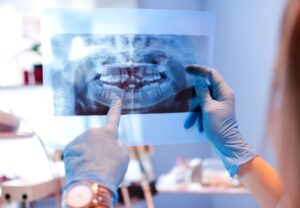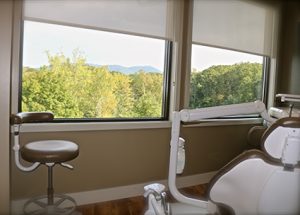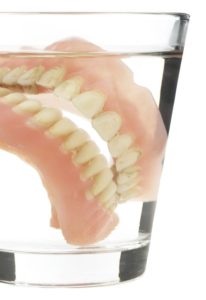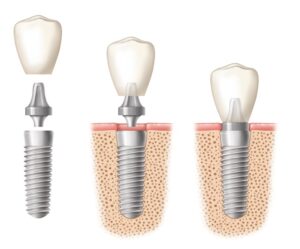Header logo
header top contact widget
Dentures/Partial Dentures
Smoking, Vaping Lead To Gum Disease, Tooth Loss.
Posted on Sep 15, 2020 by William J. Claiborne, DDS MS
With all good intentions, adults occasionally trade one bad habit for another. For instance, a commitment to exercise more often for weight loss can easily backfire when justifying a thick smoothie as a daily reward.
This is what worries me about Vaping. Vaping, the use of e-cigarettes, hit the market around 2007. It is designed to deliver nicotine through a vapor. Although the vapor is generally not labeled as harmful (it’s not “safe”, either), its nicotine is no less harmful to the user as that delivered via cigarette smoke.
Unfortunately, many cigarette users switched to vaping based on the perception that “e-cigs” were a safer alternative. For those who wanted to wean themselves off of cigarettes through this switch, very few achieve that goal as a result.
A 2018 report by the National Academy of Sciences, Engineering, and Medicine concluded there was “evidence that e-cigarette use increases the frequency and intensity of cigarette smoking in the future.”
Teens have been most susceptible to the hazards of vaping. It is the most commonly used tobacco product among U.S. youth. E-cigarette use among middle and high school students increased 900 percent during 2011-2015. According to the Surgeon General, 1 in 5 high school students and 1 in 20 middle school students were using e-cigarettes in 2018.
Unfortunately, nicotine exposure can harm the brain as it develops, until about age 25. During adolescence, nicotine use can affect learning, memory and attention span as well as increase their risk for future drug addictions. (https://e-cigarettes.surgeongeneral.gov/documents/surgeon-generals-advisory-on-e-cigarette-use-among-youth-2018.pdf)
As a periodontist in Asheville, NC, my concern when it comes to oral health is what many cigarette smokers and vapers don’t realize when it comes to high risks to their smiles.
In our periodontal dental office, I’ve seen how significantly the habit of cigarette smoking can have on one’s smile. It’s no secret that smoking cigarettes can stain teeth and cause bad breath. However, nicotine in any form is a hazardous force in the mouth.
According to the American Dental Association (ADA), smoking can cause the gums to recede from teeth, exposing vulnerable tooth root sections. This enables easier entry of oral bacteria into the structures that support tooth roots. Smoking can also delay healing following periodontal therapy, extractions or implant placement. The longer it takes oral tissues to heal, the greater the risks for infection to develop.
Additionally, smoking increases the risks of oral cancer, lesions inside the mouth, periodontal (gum) disease, enamel erosion and tooth loss. It greatly reduces saliva flow in the mouth, which is a tremendous aid in removing bacteria and food particles from the mouth, helping to control bacteria levels. The condition of “dry mouth” also causes bad breath.
Because of the vape’s moist presence in the mouth, the assumption with vaping over smoking cigarettes is the “benefit” of oral dryness. However, this is easily dispelled when looking at the true facts.
While there are more than 7,000 chemicals found in the smoke of tobacco products, (including nicotine, tar, carbon monoxide, acetaldehyde and N-nitrosamines), nicotine is the primary addicting component. A study of some e-cigarette products found the vapor contains known carcinogens and toxic chemicals, as well as potentially toxic metal particles from the device itself.
The e-liquids delivered by these devices typically contain nicotine, propylene or polyethylene glycol, glycerin, and additives. Sound safe? Not at all.
According to the Centers for Disease Control & Prevention (CDC), a smoker has twice the risk for gum disease compared with that of a nonsmoker. (https://www.cdc.gov/tobacco/campaign/tips/diseases/periodontal-gum-disease.html)
When a patient is diagnosed with advanced periodontal disease (periodontitis), they must make a commitment of time and expense to rid this inflammatory disease from their mouths. For those who ignore its presence or assume it will get better on its own, the disease will simply progress further.
Gum disease begins with sore gums that may bleed while brushing teeth. Or, it may cause no noticeable symptoms at all in early stages.
As it worsens, gum disease will cause frequent bad breath, tender gums that turn red, gum recession, and gums that bleed easily when brushing. Pus pockets may form on the gums. As it attacks the structures beneath the gum line, teeth may loosen or shift.
As the nation’s leading cause of adult tooth loss, it brings the hard decisions (and expense) for replacement. After all, you need teeth for eating and speaking. Do you go with dental implants? Or, do you take on the challenges that come with dentures and partials? As hard as the decisions of replacing teeth can be, gum disease can bring even more devastation with it.
Research has linked the bacteria of gum disease to serious health problems. These include heart disease, stroke, preterm babies, arthritis, diabetes, impotency, some cancers and even Alzheimer’s disease. These connections occur through the infectious bacteria of gum disease entering the bloodstream through tears in diseased gum tissues.
Once in the bloodstream, the bacteria can travel throughout the body and create inflammatory reactions. This “systemic inflammation” is able to trigger the onset of some diseases and conditions or even further the development of others.
Certainly, we all have the right to determine what is in our best interest as far as our own health goes. However, I believe that many individuals end up in our office with serious gum problems and facing tooth loss because of what they did not know. Having factual information allows us to make wise decisions for our health and well-being.
As a periodontist, I have advanced skills in the treatment of all stages of periodontal (gum) disease. My dental specialty also includes the diagnosis and placement of dental implants. Here, our patients can relax under Oral or IV sedation (“twilight sleep”) while having their smiles restored. We also create a customized care program that allows each person to maintain good oral health once their treatment is complete.
 If you smoke or vape, don’t assume “that won’t happen to me.” The reason we wear seat belts in cars is because there are great risks when we do not. The risks for losing your teeth and having potent bacteria running rampant through your system is something you can take easy measures to prevent.
If you smoke or vape, don’t assume “that won’t happen to me.” The reason we wear seat belts in cars is because there are great risks when we do not. The risks for losing your teeth and having potent bacteria running rampant through your system is something you can take easy measures to prevent.
Experiencing symptoms associated with gum disease? We urge you to schedule an examination appointment as soon as possible. Call our beautiful, comfortable Asheville office at 828-274-9440. A referral is not necessary.
How To Avoid Thinning Jaw Bones That Cause “Granny Look”
Posted on Sep 10, 2020 by William J. Claiborne, DDS MS
Imagine your mouth begins to sink into your face. Deep wrinkles form around your mouth and the corners of the mouth begin to turn downward, even when you smile. Jow ls form, allowing skin to seem to loosen and hang on both sides of the face. The chin becomes more pointed and the nose and chin get closer and closer.
ls form, allowing skin to seem to loosen and hang on both sides of the face. The chin becomes more pointed and the nose and chin get closer and closer.
This sounds pretty awful. It is like a disfigurement of the face. It’s not a horror movie, though. This is real, caused by one of the most preventable of all diseases afflicting American adults. It’s a disease that affects over 47 percent of all adults over the age of 30. For adults over the age of 65, the figure rises to over 70 percent. (https://www.cdc.gov/oralhealth/conditions/periodontal-disease.html)
Amazingly, this highly prevalent disease is simply periodontal disease. Often referred to as gum disease, some people also refer to it as “perio.” These are fairly familiar terms when it comes to what adults endure. Yet, it seems to be easily ignored, which merely allows it to progress further.
Before we get into the causes (and easy prevention measures) of gum disease, let’s examine how the dreaded changes in facial appearance are related to it.
Gum disease is the nation’s leading cause of adult tooth loss. Assumed to be a normal part of the aging process, it is anything but. Yes, older adults are more prone to acquiring gum disease due to a reduction in saliva and perhaps being less efficient at oral hygiene. But losing teeth can be prevented, and should be.
The problem with losing natural teeth has to do with their roots. It is the roots of a tooth that serve a much greater purpose than most people realize. While the appearance and function of dentures and partials (albeit reduced) can be replaced, they do nothing to replace what is lost beneath the gum line.
Simply put, the lack of tooth roots is the beginning of a “melting face.” This leads to bone loss and is known as resorption. Resorption is the shrinking of the bone structures that support teeth. As tooth roots are absent, the loss of bone mass can create a number of problems – both related to oral health and in facial appearance.
Tooth roots are a living part of your skeletal structure. Tooth roots are what provide nourishment and stimulation to the jaw bones. This helps the jaws to maintain a healthy mass. When tooth roots are removed, the bones slowly begin to shrink. Although most people don’t notice anything different for a while, bone loss begins almost immediately.
As described at the beginning of this article, there is a ‘look’ of bone loss, which causes changes in facial structures. This is because the bone mass is shrinking. As it shrinks, muscles detach and facial skin hangs looser.
Initially, you may only notice more wrinkles around the mouth. As it worsens, you may realize your chin seems to be more pointed. The extreme visual change of bone resorption is referred to as a ‘granny look.’ This causes people to appear far older than their actual age.
For those who wear a denture or partial, losing jaw bone mass also causes a change in the way the denture or partial fits. For example, a denture may fit fine the first year after teeth are removed and a denture is fitted. However, you’ll eventually notice slips when biting or chewing. This is because the bone under the “arch” that supports the denture or partial is declining in height.
The changing foundation for the denture allows it to “slip” or become “wobbly.” As bone loss continues, you may experience uncomfortable rubbing on tender gum tissues while eating. You may start to bypass foods that require rigorous chewing, opting for softer foods that dissolve quickly in the mouth. Outings with friends and family seem to be overshadowed by the fear of embarrassing slips.
Eventually, even frequent applications of denture pastes or adhesives are of little help. A reline may be recommended by your dentist to reshape your denture or partial to fit the reduced contours of the gum ridge (or “arch”). Continued bone loss will require yet another reline as the ridge flattens further.
Denture wearers are typically unaware that the pressure on the gums from wearing a denture accelerates the rate of bone loss. For those who sleep in their dentures, this means that pace of bone loss occurs 24/7.
Sleeping in a denture can also add to higher risks for the flu and pneumonia. A 3-year study of more than 500 adults was published by the Journal of International Oral Health. Of the 186 (of 453 denture wearers) who did not remove their dentures for sleeping, they had over twice the risk for pneumonia than those who did. Sleeping in dentures also led to higher levels of tongue and denture plaque, gun inflammation and other oral issues.
(https://www.ncbi.nlm.nih.gov/pmc/articles/PMC4295446/)
When it comes to replacing natural teeth, there are many reasons we recommend dental implants, a major advantage being their ability to halt bone loss. Because dental implants act as replacement tooth roots, they are able to restore stimulation to the jaw bones.
Additionally, dental implants use the same, sturdy foundation as natural teeth once had. This means you can bite and chew the foods you love (including that thick steak) without fearing embarrassment or uncomfortable rubbing against tender gum tissues.
Dental implants are also designed to last a lifetime, making them a wise investment.
A particular skill of the periodontal specialty is the advanced training in the diagnosis and placement of dental implants. This training allows the specialist to determine the best dental implant type for your needs. A periodontist can also enhance your outcome through proper placement.
If you are missing natural teeth or have become frustrated with a denture or partial, call 828-274-9440 for a consultation in our Asheville periodontal dental office. During this time, we can discuss the implant system that may be most appropriate for your needs. I’ll also be happy to explain the procedural process, comfort options, and easy payment plans.
For a smile that looks beautiful and functions to support good health, don’t let the detrimental effects of dentures lead to a “granny look”. Dental implants can help you enjoy a confident, worry-free smile through your lifetime.
Considering Dental Implants? Why A Specialist Should Be Your Choice.
Posted on Jun 22, 2020 by William J. Claiborne, DDS MS
With added safety precautions and appointment protocols, our Asheville periodontal dental office has resumed a full schedule. And, we are busy!
In spite of the challenges surrounding a global pandemic, people are still in need of treatment for gum disease. Especially now. Gum disease is an inflammatory disease that is an added burden to the immune system. Because our immune systems need to be operating at peak levels to fight infection, healthy gums are being given renewed recognition.
As a periodontist, I also specialize in the diagnosis and placement of dental implants. We continue to provide this much needed option to patients in need of replacing teeth. After all, regardless of the challenges people face, they still need to be able to bite, chew, and speak.
When it comes to a partial or bridge to replace teeth, a patient faces future risks. Because a partial or bridge rely on adjacent teeth for support, the natural tooth (teeth) that serve to support these appliances bring on a significant challenge.
These dental prosthetics place added pressure and stress to the supporting natural teeth. Thus, there is a greater potential for damage to the structure of the natural teeth. This places those “crowned” teeth at risk for being the next to be lost.
Americans are coming to know that a denture creates a great many challenges. One of the most common complaints has to do with dentures that begin to move or ‘slip’ when eating or even speaking. This is due to bone loss that is occurring under the denture.
Without stimulation to the jaw bone where tooth roots were once supported, the bone begins to shrink. This is known as resorption. As resorption continues, the denture that was designed to the unique shape and height of this gum-covered ‘arch’ no longer provides a snug fit.
Because of this, denture wearers come to rely on denture adhesives and pastes. However, over time even frequent applications of these products are of little help. Relines, another option, can be done to reshape the denture’s base to conform to the shrinking arch. Eventually, even relines provide minimal improvement.
Bone loss also shows up in facial appearance. As the bone structures that give our face its shape start to shrink, deep wrinkles form around the mouth. Eventually, the corners of the mouth will turn downward, even when smiling. Jowls form on each side of the face as facial muscles detach from the declining bone structure.
As the jaw bone continues to shrink, the chin becomes more pointed and the nose seems to move closer to it. This leads to a collapsed mouth, sometimes referred to as a ‘granny look.’ This look ages the appearance of an individual that is far beyond their actual years.
However, the greatest challenge is when eating becomes a struggle. Because of movement and resulting sore spots on tender gum tissues, foods that require biting and rigorous chewing are often set aside for softer foods that dissolve quickly in the mouth.
Unfortunately, these food choices often offer less-than-ideal nutritional benefits, and typically very little fiber. It’s no wonder that denture wearers tend to have more gastrointestinal problems than people who are able to chew sufficiently and comfortably.
To me, what is especially troubling for long-time denture wearers is the avoidance of social gatherings. Studies have shown that being socially involved helps adults be more active both physically and mentally.
In a February 2019 article, Science Daily shared, “Researchers at The University of Texas at Austin have found that older adults who spend more time interacting with a wide range of people were more likely to be physically active and had greater emotional well-being.” (https://www.sciencedaily.com/releases/2019/02/190220074610.htm)
When adults fear embarrassing slips, clicks, or uncomfortable food pieces that become trapped between the gums and denture, declining social invitations becomes more and more frequent. Since many social gatherings include food or are centered around meals, denture-wearing adults have difficult choices to make. Go and hope for the best or risk an embarrassing moment?
As dental implants have become a more practical and popular option, adults are turning away from dentures, partials, or bridges. In addition to restoring biting and chewing comfort and stability, implants offer a lifetime replacement option that actually enhances the well-being and lifespan of surrounding teeth.
In dental implant treatment, the ‘implanted’ portion is positioned into the jaw bone as a tooth root replacement. This provides the attached teeth the same foundation as natural tooth roots have. This also recreates stimulation to the bone, halting the process of bone loss.
So, why should you search out a periodontist for your dental implant treatment? With so many one-stop clinics and online implant “special price today only!”, is the care of a periodontal specialist really needed?
Below are some reasons to consider how your dental implant treatment begins. Because, in the long run, it is a significant factor in the end result.
• Proper diagnosis: A periodontal specialist has advanced training to properly diagnose and place the most appropriate dental implant system for your needs and goals.
• Appropriate treatment: I have a reputation for never over-treating or under-treating. We structure treatment to provide the most successful outcome based on each patient’s unique needs by the most conservative means possible. Thus, the patient avoid having more time and expense than is necessary.
• Proper tools & equipment: As a periodontal office, we are fully prepared for the diagnosis and treatment of all stages of gum disease as well as the placement of dental implants. As such, we can tend to our patients in an efficient and effective manner. This also enables us to provide treatment in minimal time and to an exceptional level of comfort.
• Advanced features: In addition to trust, one of the reasons we receive so many referrals from physicians, dentists, and past/present patients has to do with the advanced technology and features we provide. We are also known for providing a high level of patient comfort through the administration of IV sedation (twilight sleep) with our on-site Board Certified Anesthesiologist. Additionally, diagnosis and treatment planning is backed by images from our on-site 3D Cone Beam technology.
• A respectful environment: We treat each patient with the same respect, compassion and gentle hands that we would want for ourselves and our loved ones. We take great pride in knowing our patients experience the finest periodontal and implant care available in the Southeastern United States.
Because of their ability to restore the presence of natural teeth to such a great extent, the dental profession now sees dental implants as the preferred choice for replacement for most patients. Although the overall treatment costs may seem greater initially, over time, it becomes obvious that the benefits far outweigh the expense.
When you consider that dental implants are designed to last a lifetime, the investment is a wise one. There are very little things in this day and age that will last as long as we do!
If you are considering dental implants, increase your potential for a successful outcome by asking a Periodontist to join your dentist in team treatment. Most general dentists have close relationships with periodontal specialists for implant placement and in treating gum disease.
Before you make your decision, you may wish to schedule a consultation to discuss your specific needs and desires. We are always happy to welcome new patients and being referred is not required. Call 828-274-9440.
The 1-2-3’s Of Dental Implants
Posted on Apr 29, 2020 by William J. Claiborne, DDS MS
Over time, certain things are often referred to in catchphrases that simplify what is being described. For example, “Kleenex” is actually a brand name that refers to tissues. “Clorox” is commonly used as a generic for bleach, even though it’s a specific brand. And, “Uber” has become a way to describe a paid means of auto transportation, even if a taxi or Lyft is being used.
This is why the term “dental implant” may be confusing to some people. This implies the replacement of a missing tooth or teeth with a base that is implanted into the jaw bone. However, to be clear, a dental implant is not an entire structure. Let’s look at the various components of a complete dental implant system. 
Although there are different types of implant systems (designed to accommodate specific needs), all work in in a similar fashion. The actual “implant” is a hollow, screw-like cylinder. This is the portion that is actually “implanted” in the jaw bone at a strategic angle and depth.
Once placed, the implant is covered over with gum tissue. For several months after, the implant goes through a process known as “osseointegration.” In this, the bone grows around the implanted portion, which secure it in place. This restores the foundation like that of natural teeth for dependable and comfortable biting and chewing stability.
This stage, often referred to as the “healing” process, typically takes several months. However, a denture or temporary can be worn comfortably so going without teeth is not a worry.
Once healing is complete, a post is secured inside the hollow core of the implant. This post will support your final replacement tooth or teeth. Most replacement teeth are made of porcelain, which provides the most durable of all materials used in dental restorations.
Porcelain is an ideal material for replacement teeth. It is less resistant to stains and provides an exceptionally natural look and feel, even reflecting light as a natural tooth.
A successful outcome in any Dental Implant treatment begins with the selection and placement process. A Periodontist has specialized training in the diagnosis and placement of all types of implant systems. This means the implant system recommended for you will be the type most suited to your individual needs and goals.
An important aspect of implant success also relies on the assessment of bone mass. When the upper or lower jaw has insufficient bone to support the implant being placed, there is a risk of failure. This can occur in implants placed too close to the sinus cavity (for upper implants) or a nerve that runs through the mandible (lower jaw).
Too, an implant requires careful selection and placement in order to adequately support the replacement teeth being attached. In some cases, as few as 4 – 6 implants can support a complete arch of teeth. This decision is best left in the hands of a periodontal specialist.
In cases of severe bone loss, a periodontist can also perform bone rebuilding procedures prior to implant placement. This is sometimes through bone grafting but most commonly the application of a bone-rebuilding material. Additionally, some implant systems, such as the “All On 4” utilize unique angles to provide support in minimal bone depth with no bone rebuilding necessary.
The best implant system for you can be determined after an examination. During this time, I can discuss options best for you and explain the process. Call 828-274-9440 to schedule an appointment. Or, ask to begin with a Consultation.
We also encourage you to share any concerns about comfort options or treatment fees. Many people avoid looking into dental implant treatment because they are afraid of the procedure or fear they cannot manage the fees. Rather than assume these are obstacles, share your concerns so we can address them head on!
Recent Posts
Categories
Archives
- September 2024
- August 2024
- July 2024
- June 2024
- May 2024
- April 2024
- March 2024
- February 2024
- January 2024
- December 2023
- November 2023
- October 2023
- September 2023
- August 2023
- July 2023
- June 2023
- May 2023
- April 2023
- March 2023
- February 2023
- January 2023
- December 2022
- November 2022
- October 2022
- September 2022
- August 2022
- July 2022
- June 2022
- May 2022
- April 2022
- March 2022
- February 2022
- January 2022
- December 2021
- November 2021
- October 2021
- September 2021
- August 2021
- July 2021
- June 2021
- May 2021
- April 2021
- March 2021
- February 2021
- January 2021
- December 2020
- November 2020
- October 2020
- September 2020
- August 2020
- July 2020
- June 2020
- May 2020
- April 2020
- March 2020
- February 2020
- January 2020
- December 2019
- November 2019
- October 2019
- September 2019
- August 2019
- July 2019
- June 2019
- May 2019
- April 2019
- March 2019
- February 2019
- January 2019
- December 2018
- November 2018
- October 2018
- September 2018
- August 2018
- July 2018
- June 2018
- May 2018
- April 2018
- March 2018
- February 2018
- January 2018
- December 2017
- November 2017
- October 2017
- September 2017
- August 2017
- July 2017
- June 2017
- May 2017
- April 2017
- March 2017
- February 2017
- January 2017
- December 2016
- November 2016
- October 2016
- September 2016
- August 2016
- July 2016
- June 2016
- May 2016
- April 2016
- March 2016
- February 2016
- January 2016
- December 2015
- November 2015
- October 2015
- September 2015
- August 2015
- July 2015
- June 2015
- May 2015
- April 2015
- March 2015
- February 2015
- January 2015
- December 2014
- November 2014
- October 2014
- September 2014
- August 2014
- July 2014
- June 2014
- May 2014
- April 2014
- March 2014
- February 2014
- January 2014
- December 2013
- November 2013
- October 2013
- September 2013
- August 2013
- July 2013
- June 2013
- May 2013
- April 2013
- March 2013
- February 2013
- January 2013
- December 2012
- November 2012
- October 2012
- September 2012
- August 2012
- July 2012
- June 2012


